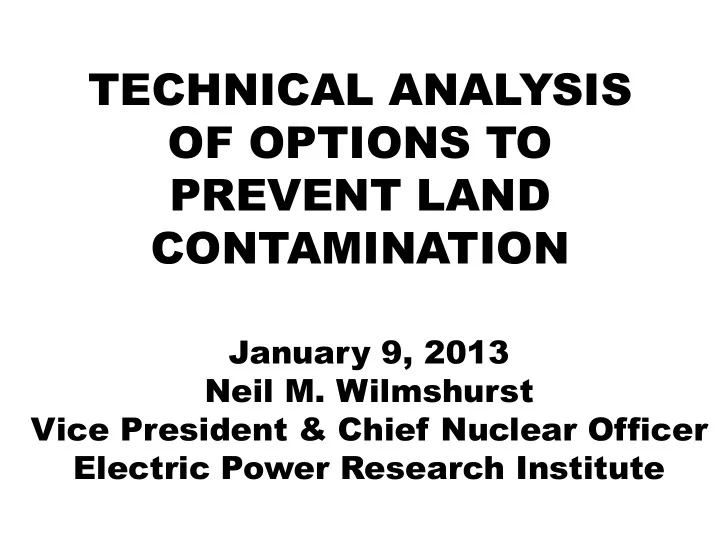

TECHNICAL ANALYSIS OF OPTIONS TO PREVENT LAND CONTAMINATION January 9, 2013 Neil M. Wilmshurst Vice President & Chief Nuclear Officer Electric Power Research Institute
The Question… What are the best operational strategies to prevent land contamination? • Re-phrased question leads to deeper understanding of the issue. • Informs development of SAMGs and development of other beyond design basis capabilities. 2
Results published Technical Report: “Investigation of Strategies for Mitigating Radiological Releases in Severe Accidents - BWR Mark I and Mark II Studies“ Report 1026539, September 2012 3
Scope - BWR Mark I and Mk II Spectrum of Accident Challenges Greater than Less than (design and beyond design basis events) 99.99% 0.01% Core Damage Prevented Core Damage Containment Containment is Containment Containment is Not Not Primary Challenged Primary Barrier Challenged Barrier to to Release Release Heat Removal Vent Steam Successful No Release Radionuclide Release Combinations of Strategies No Release SAMGs and FLEX provide Considered some mitigation FLEX provides additional protection for these scenarios Containment Spray Containment Flood Filtered Vent Containment Vent Unfiltered Vent 4
Post Accident Actions • Avoid core damage. • If core damaged – cool damaged core. • If core exits vessel - protect containment: – Cool corium – Vent when needed – Remove radioactive material from gas stream 5
Decontamination Factor Relative Magnitude of Contaminated Land Diminishing Benefit as DF Reaches 1000 1 10 100 1000 10000 Overall Decontamination Factor (DF) (DF = 1 / fraction of cesium released) 6
BWR Mark I Results 10,000 Overall Decontamination Factor DF = 1/Fraction of Cs Released 1,000 100 Without Core Debris Elements Exist in Cooling - Eventual Current SAMGs and Breach of Containment in FLEX 10 1 7
BWR Mark II Results 10000 Lefthand bar for each category is the wetwell bypass value Elements Exist in Current SAMGs and in FLEX Right hand bar for each category is the no-bypass value 1000 Overall Decontamination Factor CF = 1/Fraction of Cs Released 100 10 1 8
Significant Conclusions • Maintain containment integrity. • Water injection into containment cools debris and filters potential releases: – Water spray and flood filter airborne aerosols – Cycling of vent maximizes aerosol capture and manages hydrogen • Decontamination factor greater than 1000 can be achieved. 9
Impact on Plants • Specific plant evaluations required. • Plant modifications may be needed: – Ensure post accident spray and/or flood – Wetwell and drywell vents required – Mark II pedestal drains may require protection – Possible addition of filters on plant specific basis 10
Acronyms • FLEX – Diverse and Flexible Coping Strategy • DF- Decontamination Factor • SAMG – Severe accident management guideline • RHV – Reliable hardened vent required by EA-12-050 11
Recommend
More recommend